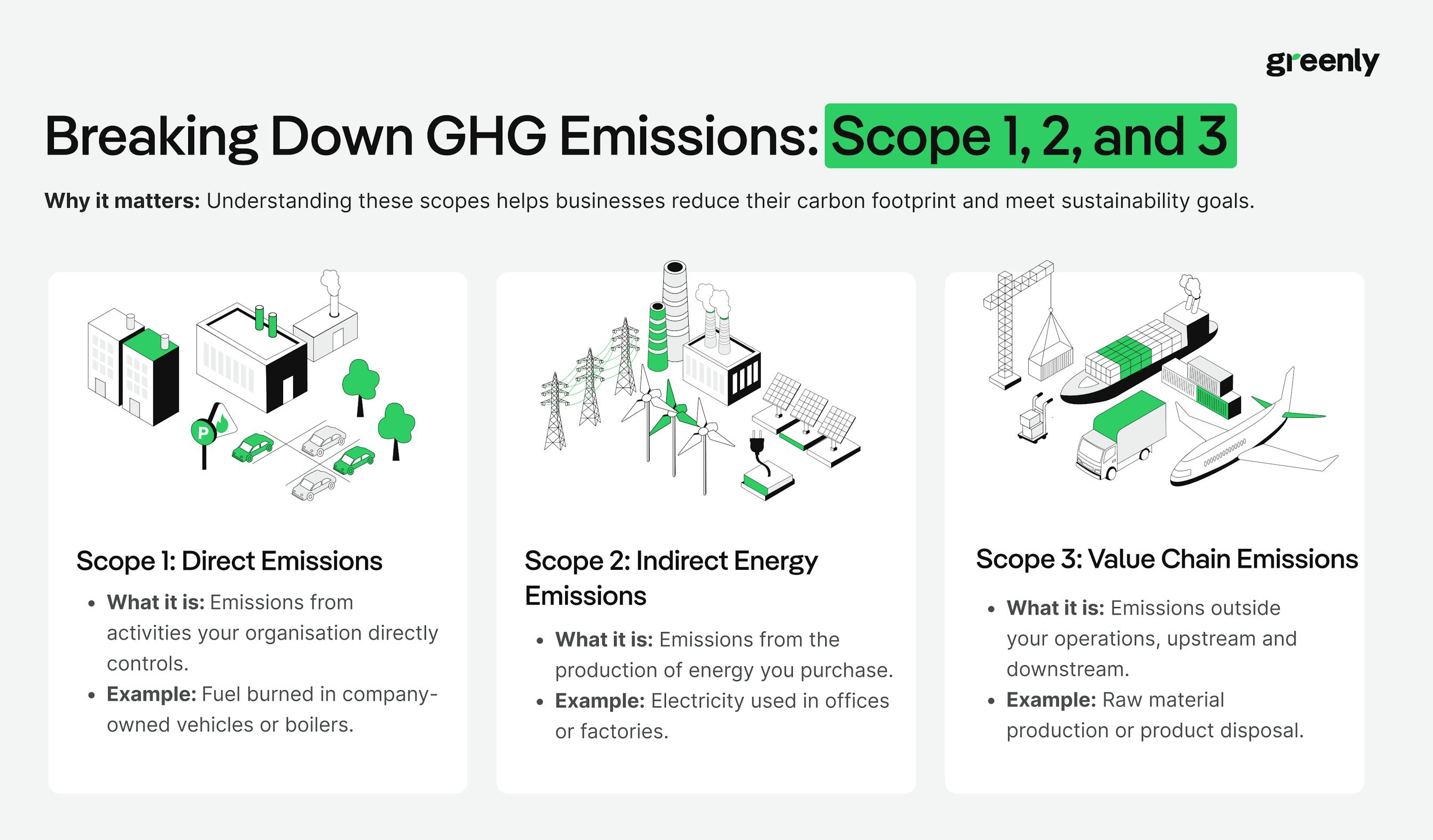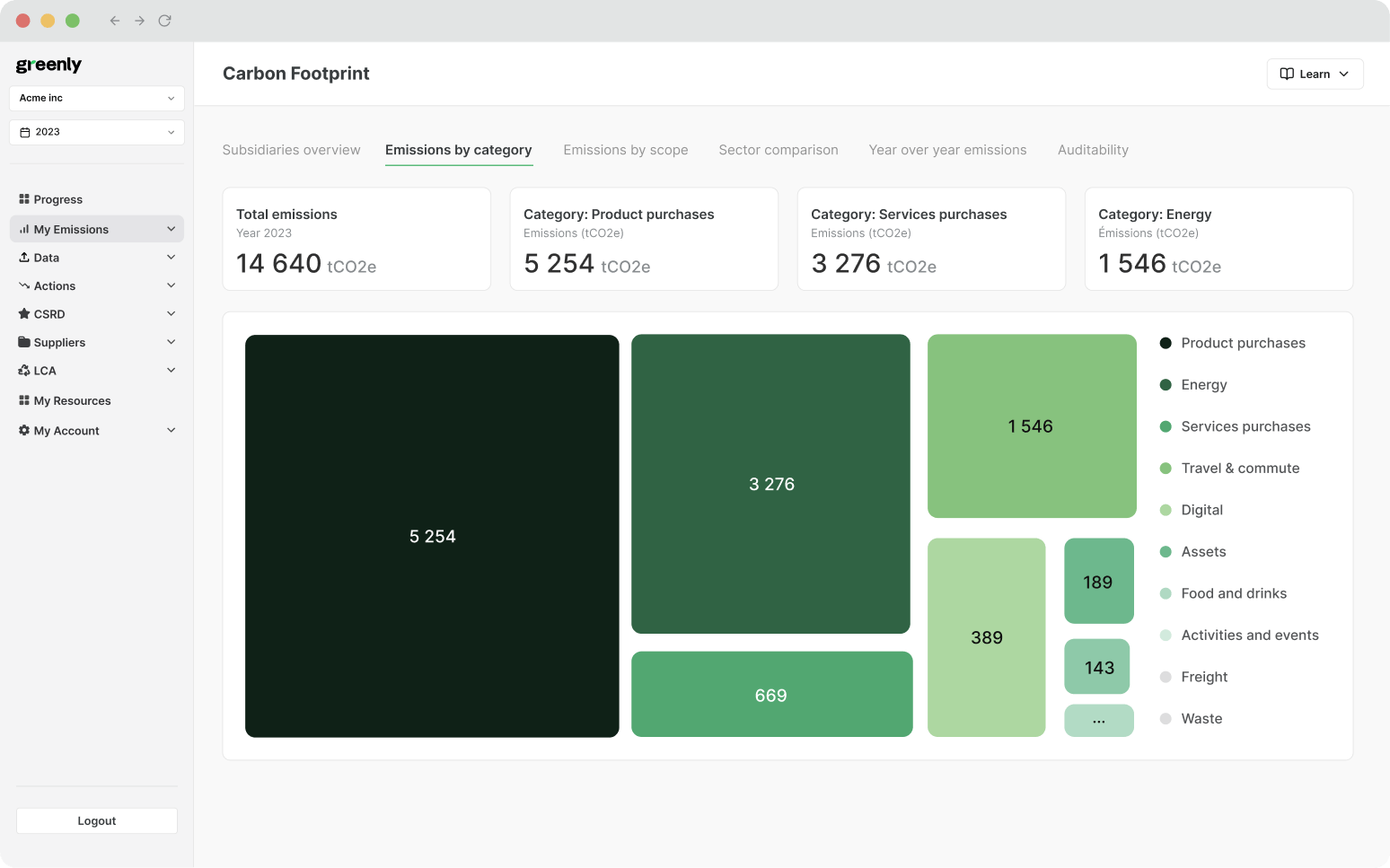
What are the 3 Pillars of Corporate Sustainability?
In this article, we'll explore what the 3 pillars of corporate responsibility are, why they're important, and how businesses can turn them into practical action.
ESG / CSR
Industries



How scope 4 emissions differ from scope 1, 2, and 3
Why companies should calculate their scope 4 emissions
If you’re familiar with the world of carbon accounting, odds are – you’ve heard about scope 1, scope 2, and the infamous scope 3 emissions – all of which are different categories used to measure the emissions produced by a company in order to help them better understand, measure, and reduce their emissions in the future… but have you heard of scope 4 emissions?
Scope 4 emissions are a new concept, and it can be difficult to keep track of them given companies already have to worry about scope 1, scope 2, and scope 3 emissions.
What are scope 4 emissions, how are they different from scope 1, scope 2, and scope 3 emissions, and how could scope 4 emissions prove useful for companies seeking to up their game in sustainability and meet their new climate targets?
Scope 4 emissions, a new term created by the World Resources Institute, refers to the emission reductions that occur outside of a value chain or the life cycle of a product – which are also commonly referred to as avoided emissions. Scope 4 emissions can also include emissions created from working at home: such as the emissions created to keep utilities on, laptops running, and to maintain central air conditioning or heating systems.
While there are currently no compulsory requirements to report scope 4 emissions, it can prove beneficial for both individuals and companies looking to reduce their emissions, improve upon their sustainability efforts, and meet their climate goals.
The timeline below will reveal how scope 4 emissions could help companies in their sustainability journey's long-term:
Scope 4 begins by assessing emissions avoided through a company’s products or services — often tied to innovations that reduce Scope 3 emissions across the value chain.
Organisations develop models to calculate how their solutions lead to fewer emissions compared to conventional alternatives, helping demonstrate measurable climate benefits.
Incorporating Scope 4 data into corporate sustainability reports gives a clearer view of total climate impact — beyond internal reductions alone.
Scope 4 tracking encourages R&D teams to design solutions that actively prevent emissions — such as energy-efficient technologies or low-carbon alternatives.
Companies that demonstrate avoided emissions leadership often gain trust from stakeholders, investors, and partners who value long-term climate alignment.
By integrating avoided emissions with ESG reporting, companies can communicate a more holistic story of environmental progress.
Ultimately, Scope 4 encourages industries to move beyond neutralising emissions and toward enabling net-positive environmental impact — a cornerstone of long-term sustainability.
An example of scope 4 emissions is when a product or service advertises the energy or emissions that have been saved as a result of the new climate or energy-saving technology associated with that product or service. For instance, this could be demonstrated with a new iPhone that has a more energy-efficient battery that will reduce the need for a user to charge the phone as often – ultimately reducing electricity usage and emissions over time.
Another example is if a car company demonstrates in their advertisement the addition of fuel-saving tires, which over time will cut back the amount of greenhouse gas emissions produced as drivers won’t need to fill up their cars as often.
A third example of scope 4 emissions is when popular events, such as Fashion Week, opt to go virtual in order to reduce the amount of potential emissions to be created from those traveling to the place of the fashion show or event.

Scope 4 emissions can also refer to the emissions created for those who work remotely from home, as remote workers will more often than not produce less emissions having virtual meetings, using the lights, and avoiding business trips by working from their own home.
Ultimately, the avoided emissions created by those who work remotely can also be considered scope 4 emissions – as the carbon footprint of these workers is likely to be greater if they were commuting to the office and traveling for business.
Scope 1, 2, and 3 emissions all differ from one another – but they are still more collectively similar to each other than they are to scope 4 emissions.
Scope 1, scope 2, and scope 3 emissions are used to divide the different categories where emissions come from – otherwise known as the different “scopes”. Ultimately, scope emissions are used to simplify the process for those who want to measure and reduce their carbon footprint.
The battle cards below will summarise the differences between scope 1, 2, and 3 emissions:
Scope 1 emissions are the emissions that come straight from the source of industrialisation production or the vehicles used in a company. This includes all sources of non-renewable energy as well – such as the energy or electricity required to run the office.
Scope 2 emissions refer to any emissions created by energy consumption – like the electricity necessary to run the air conditioning or central heating in the office.
Scope 3 emissions are the rest of emissions that are produced that don’t fall under scope emissions 1 or 2, and to make them even more difficult to measure and reduce – scope 3 emissions occur from activities that happen outside of the company: such as from the commuting habits or employees or the emissions created from business travel.

Scope 1 and scope 2 emissions are similar to one another as in the company has full control over the production of these emissions – whereas scope 3 emissions are caused by activities that occur outside of the company.
The main difference between scope 1, 2, and 3 emissions from scope 4 emissions is that scope 1, 2, and 3 emissions are already being produced and require action from the company to develop new ideas to reduce them, whereas scope 4 emissions are emissions that aren’t being created in the first place thanks to the business choices of a company and various technological advancements.
All of the other scope emissions are considered to be indirect emissions, whereas scope 4 emissions are considered to be avoided emissions.
Ultimately, scope 4 emissions should not be considered when seeking to calculate for scope 1, scope 2, and scope 3 emissions – as scope 4 emissions are part of a completely different category than the rest of the other scope emissions.


Scope 4 emissions are important because they can help companies to reduce their carbon footprints more easily and effectively while also benefiting the environment and their future business endeavors. This is because scope 4 emissions aren’t an environmental impact that is typically monitored by companies in the way that scope 1, scope 2, and scope 3 emissions – making them like a secret weapon for companies trying to stay ahead of their climate game.
If more companies seek to understand their scope 4 emissions, it can help them to create new ideas on how to reduce this lesser known source of emissions – and ultimately encourage more sustainable tactics like cultivating a more efficient supply chain or making the switch to the use of renewable energy.
The interactive flip cards below (move cursor over card to flip) will reveal some of the reasons why scope 4 emissions are important:
Think of scope 4 emissions in the same way as someone trying to keep weight off – while monitoring what and how they eat is important, supplementing with other activities such as being active and going to the gym are bound to help them reach their goals.
Coinciding with scope 4 emissions can ultimately help individuals and companies to meet their emission reduction goals faster than if they solely focus on reducing their carbon footprint through mitigating indirect emissions.

There are several benefits to be had by those who choose to report their Scope 4 emissions, as the concept is still new and taking off. Scope 4 emissions allow businesses to share and shed light on how their product or service ceases to impact the environment in a new way that is not represented through the data of their emission reductions. Ultimately, adhering to the reporting scope 4 emissions can help companies to meet both their environmental and sustainability goals.
Think of companies that share the money customers will save if they switch to their product or service, such as a cell phone company, instead of how they have reduced the price of their own individual cell phone plan – scope 4 emissions function in the same way, as it will show customers what emissions will be avoided instead of what still needs to be reduced.
Other benefits of scope 4 emissions reporting include:
Encourages openness about a company’s environmental performance, building trust with clients and future customers.
Helps customers make environmentally conscious decisions with clear data on company impact provided through Scope 4 emissions.
By highlighting avoided emissions, Scope 4 enhances reputation and attracts investors — supporting an efficient and sustainable supply chain.
More precise data from Scope 4 reporting helps identify environmental and operational risk factors earlier.
Promotes better understanding of product life cycles and sparks new ideas for low-carbon manufacturing processes.
Responds to global consumer preferences for sustainable, low-carbon products and services that reduce overall emissions.
Are all of the benefits of scope 4 emissions worth the time and effort for companies to adhere to the reporting requirements for scope 4 emissions?

The challenge with trying to calculate scope 4 emissions as opposed to the other scope emissions is that scope 4 emissions haven’t actually been produced – and it is like trying to measure an estimate of something. Think of scope 4 emissions as a city that attracts a lot of tourists trying to determine how many tourists are expected to pass through in the upcoming year – that estimate will be based off of the current trajectory of tourists that choose that city. The same goes for avoided emissions, or scope 4 emissions, as it will be difficult to determine the exact amount of emissions to be avoided until the product has actually been put to the test.
Ultimately, measuring scope 4 emissions requires more effort than measuring emissions such as those from scope 1 or scope 2.
However, that doesn’t mean measuring scope 4 emissions are impossible, and in fact – it is a valuable climate strategy that companies seeking to reduce emissions and become more sustainable should seek to implement measuring scope 4 emissions into their business models. You can find numerous tools online that provide deeper insights into measuring your emissions. But one of the best ways to measure scope 4 emissions is to use a carbon accounting platform, like Greenly, to ensure that your company has the expertise it needs to properly, personally, and accurately measure the avoided emissions of your products and services.
Carbon accounting platforms like Greenly will help you to measure your scope 4 emissions by using various data to be collected from your company: such as invoices from your suppliers, your typical utility bills, or other various documents to be provided. Ultimately, the most surefire way to calculate your scope 4 emissions is to recruit the help of a third party – such as a carbon accounting software provided by companies like Greenly.
It’s still important to understand, measure, and reduce scope 1, scope 2, and scope 3 emissions – companies that choose to measure and understand their avoided emissions, or scope 4 emissions, could help themselves to reach their emission reduction targets faster while simultaneously gaining the interest and trust of new customers and investors that could help to further propel their business.
If reading this article about what scope 4 emissions are and how to reduce them has made you interested in reducing your carbon emissions to further fight against climate change – Greenly can help you!
It can be hard to identify scope 4 emissions and subsequently reduce them, but Greenly can help you take the concrete action necessary to properly determine where – click here to book a demo and get started with your climate journey today.
Greenly can help you make an environmental change for the better, starting with a carbon footprint assessment to know how much carbon emissions your company produces.
